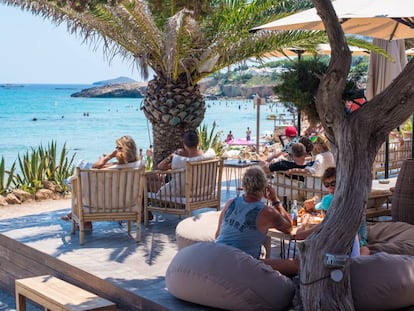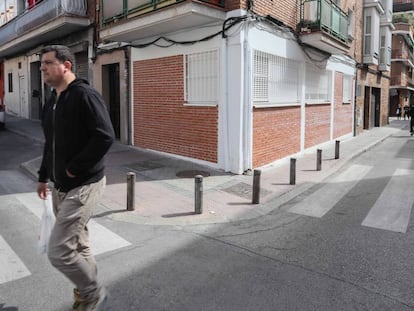Ibiza Town dethrones San Sebastián as the most expensive Spanish city to buy a home
Local politicians say short-term rentals are responsible for the soaring property prices, which have risen more than 56% in the past five years


For 12 years, San Sebastián in Spain’s northern Basque Country region has been the city with the highest property prices in Spain. But Ibiza Town, the capital of the Balearic Island of Ibiza, has now taken this title, with prices reaching €3,709 per square meter in the second quarter of the year, according to the latest statistics from the Public Works Ministry. Politicians and real estate experts agree that tourism is the main factor driving up the cost of property.
The rise of Ibiza Town’s property prices has been vertiginous and somewhat unexpected. During the property bubble in the early 2000s, prices in the Balearic city remained relatively reasonable. Among municipalities with a population of more than 25,000, Ibiza Town had the 45th most expensive homes, behind Cádiz, Getafe (Madrid) and El Prat de Llobregat (Barcelona), according to official statistics from the second quarter of 2008.
We have a limited amount of land and we don’t have the option of spreading out into nearby municipalities
Jeffrey Fernández de Bobadilla, Balearic Islands Official Association of Real Estate Agents
But all that changed when the property bubble burst. In the second quarter of 2009, Ibiza Town had already jumped to 26th position. And five years ago, it was in eighth place, lagging only behind San Sebastián, Madrid and Barcelona, and several wealthy outlying areas of these two big cities.
The value of property in Ibiza has risen 56.5% in the past five years. Only L'Hospitalet de Llobregat in Barcelona saw a greater spike in prices, with a rise of 58%. But, L'Hospitalet de Llobregat’s starting point was far lower, as prices bottomed out in the crisis. Meanwhile in Ibiza Town, prices fell less and bounced back a lot earlier.
In fact, in the six most expensive municipalities right now – Ibiza Town, followed by San Sebastián, Santa Eulària des Riu (also on the island of Ibiza), Sant Cugat del Vallés (Barcelona province), Barcelona and Madrid – only in Ibiza Town and Santa Eulària are apartments worth more than they were before the crisis – 27% and 19%, respectively.
The spike in prices is due to a “combination of a number of factors,” says Elena López, a local councilor for the Socialist Party (PSOE), who oversaw the housing department of housing under the previous mandate, and is now in charge of urban development. “The city covers 11 square kilometers [10 times smaller than Barcelona and 60 times smaller than Madrid]. Forty percent of that is rural land and the rest is consolidated urban land. It’s practically all taken.”
“We have a limited amount of land and we don’t have the option of spreading out into nearby municipalities if we don’t find what we want,” adds Jeffrey Fernández de Bobadilla, a delegate for Ibiza in the Balearic Islands Official Association of Real Estate Agents.
Properties in Ibiza are worth 27% more than before the crisis
Sergio Carrasco, a lawyer for the Ibiza Affected by Rents platform, agrees: “The island is very small. And there’s a lot of demand and little on offer.”
Although the data from the Public Works Ministry is based on the assessment value of a property, tourist apartments are singled out as being the main cause for the rise in prices. “If there are 50,000 registered residents, 400,000 people arrive in August and there are 150,000 tourist places. Where do the rest go?” asks Aitor Morrás, the local housing councilor for the anti-austerity party United Podemos. “To homes that are being used for tourism,” he says.
José Vicente Marí, from the conservative Popular Party (PP), agrees that “the tourism market has a lot of influence” on property prices. Marí, who stood for mayor at the local elections in May, argues that the city was able to bounce back from the crisis by improving tourism infrastructure and opening up to the luxury market. While this was a “positive process,” it affected the cost of housing, says Marí.
But while political parties agree there need to be more inspections to clamp down on illegal tourist apartments – they are banned from all residential buildings – it is hard to get a consensus on potential solutions. Marí believes that a new zoning plan (PGOU) needs to be approved as soon as possible to allow new homes to be built.
The current city council does not agree. Morrás, the head of the housing department, says that, according to the land registry, the city has 23,715 properties for 50,000 inhabitants. “There are plenty of properties but we suspect that too many are being used for tourists and we have to discover which,” he explains, adding that he would like to see a door-to-door census compiled as the macro data is proving “useless.” “You have to do it on a micro scale,” he says.
Fernández de Bobadilla, meanwhile, insists that the sector, which was deregulated in 2000, needs to be professionalized to avoid speculation at the “expense of the local people.”
Carrasco adds: “It’s not that it’s hard to buy, it’s impossible because salaries have not risen in line with prices.”
Impact of tourist apartments
The concentration of tourist properties is the most significant factor when it comes to property prices in the markets of the islands. This is one of the conclusions drawn by the first edition of the Impact of Tourism Property Observatory (OIVT), presented recently in Madrid. But while prices rise in tandem with concentration, there is a point where the price rise tapers off if the concentration reaches saturation point.
As far as Spain’s Balearic and Canary Islands are concerned, the saturation point is reached quickly. “We understand that this saturation happens from the start probably because of the high concentration of tourist properties in these markets,” explains Iñigo Amiano, the advisor to Krata, a property valuation society, which is behind the study.
So far, the study’s authors have not pinpointed why saturation should have this effect but it could be that high numbers of tourists discourage locals from buying and also that excessive competition acts as a deterrent for investors wanting to make money from short-term rentals.
The OIVT has analyzed the evolution of prices of 20 million properties over the period of a year in relation to the distribution of more than 342,000 tourist properties advertised on online accommodation platforms such Airbnb.
Using census sections as a point of reference, the OIVT divided the properties into four types: those with no tourist properties, those with up to 1%, those with 1% to 7%, and those with over 7%. In this last bracket, the prices always rose less than in the 1% to 7% bracket, except for in Madrid.
English version by Heather Galloway
Tu suscripción se está usando en otro dispositivo
¿Quieres añadir otro usuario a tu suscripción?
Si continúas leyendo en este dispositivo, no se podrá leer en el otro.
FlechaTu suscripción se está usando en otro dispositivo y solo puedes acceder a EL PAÍS desde un dispositivo a la vez.
Si quieres compartir tu cuenta, cambia tu suscripción a la modalidad Premium, así podrás añadir otro usuario. Cada uno accederá con su propia cuenta de email, lo que os permitirá personalizar vuestra experiencia en EL PAÍS.
¿Tienes una suscripción de empresa? Accede aquí para contratar más cuentas.
En el caso de no saber quién está usando tu cuenta, te recomendamos cambiar tu contraseña aquí.
Si decides continuar compartiendo tu cuenta, este mensaje se mostrará en tu dispositivo y en el de la otra persona que está usando tu cuenta de forma indefinida, afectando a tu experiencia de lectura. Puedes consultar aquí los términos y condiciones de la suscripción digital.
More information
Archived In
Últimas noticias
Maduro pleads not guilty before the federal court in New York: ‘I am still the president of Venezuela’
A new test can detect Alzheimer’s from a finger prick
UN team enters Sudanese city of El Fasher after paramilitary massacre: ‘It’s like a ghost town’
A recipe for resistance: Indigenous peoples politicize their struggles from the kitchen
Most viewed
- Gilles Lipovetsky: ‘If you want to live better and fall in love, take Prozac, don’t look to philosophy’
- Alain Aspect, Nobel laureate in physics: ‘Einstein was so smart that he would have had to recognize quantum entanglement’
- Alvin Hellerstein, a 92-year-old judge appointed by Bill Clinton, to preside over Maduro’s trial in New York
- Maduro’s downfall puts China’s relationship with Venezuela to the test
- Why oil has been at the center of Venezuela-US conflicts for decades










































